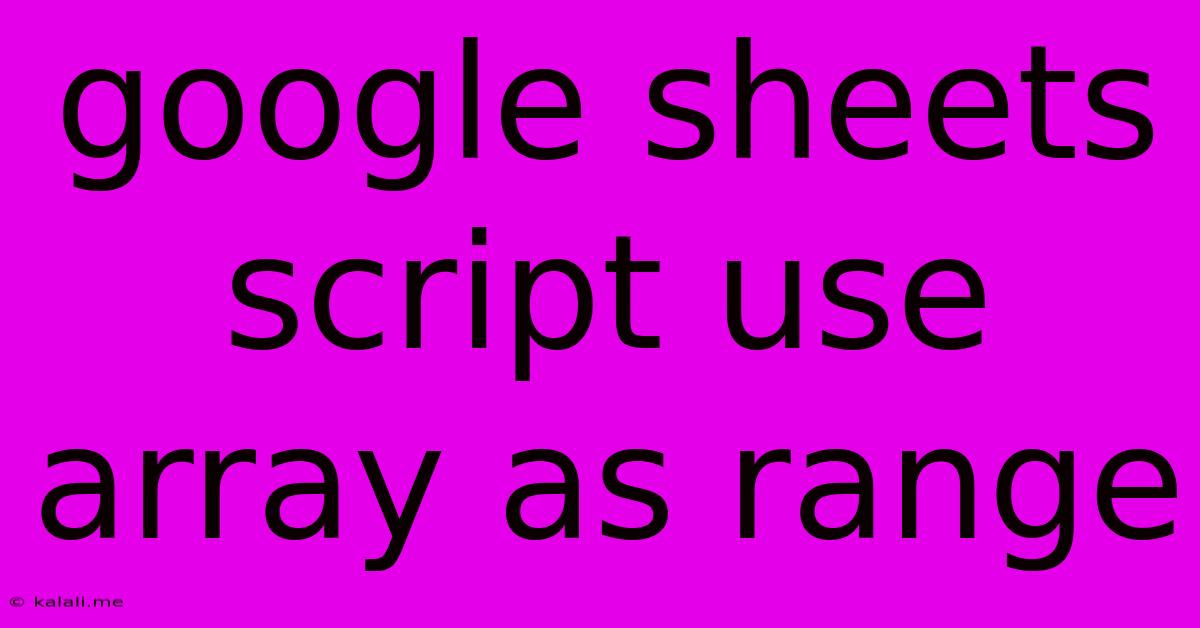Google Sheets Script Use Array As Range
Kalali
Jun 07, 2025 · 3 min read

Table of Contents
Using Arrays as Ranges in Google Sheets Script: A Powerful Technique
This article explores the powerful technique of using arrays as ranges within Google Apps Script for Google Sheets. This method offers significant performance advantages, especially when dealing with large datasets, over traditional range-based approaches. Learn how to leverage arrays for faster and more efficient data manipulation in your Google Sheets scripts.
What are the benefits of using arrays? Using arrays instead of directly manipulating ranges within your Google Sheets script offers several key performance benefits:
- Speed: Processing data within an array is significantly faster than repeatedly interacting with the Google Sheets API. This is because accessing and modifying cells individually through the
SpreadsheetAppobject is a relatively slow operation compared to working directly with data structures in memory. - Efficiency: Array-based operations reduce the number of calls to the Google Sheets API, leading to a more efficient script overall. Fewer API calls translate to faster execution and lower consumption of Google Apps Script quotas.
- Flexibility: Arrays allow for more complex data manipulation techniques, enabling you to perform calculations and transformations on entire datasets without the need for iterative cell-by-cell operations.
How to use arrays as ranges:
The core idea is to retrieve data from a Google Sheet as a two-dimensional array, perform operations on that array, and then write the modified array back to the sheet.
Here's a breakdown of the process:
-
Get the range as an array: Use the
getValues()method to retrieve the data from the desired range in your spreadsheet as a two-dimensional array.function getRangeAsArray() { // Get the spreadsheet and sheet. let spreadsheet = SpreadsheetApp.getActiveSpreadsheet(); let sheet = spreadsheet.getSheetByName("Sheet1"); // Replace "Sheet1" with your sheet name // Get the data range. let range = sheet.getRange("A1:B10"); // Replace "A1:B10" with your desired range // Get the values as a 2D array. let dataArray = range.getValues(); Logger.log(dataArray); // Log the array to the Apps Script execution log. return dataArray; } -
Manipulate the array: Now that you have the data in an array, you can perform any necessary operations. This could involve:
- Calculations: Applying formulas or functions to individual elements or across the entire array.
- Filtering: Removing rows or columns based on specific criteria.
- Sorting: Ordering the data based on one or more columns.
- Transformations: Changing data types, formatting, or applying custom functions.
function manipulateArray(dataArray) { // Example: Adding 10 to each element in the array for (let i = 0; i < dataArray.length; i++) { for (let j = 0; j < dataArray[i].length; j++) { dataArray[i][j] += 10; } } return dataArray; } -
Set the array back to the range: Finally, use the
setValues()method to write the modified array back to the Google Sheet. Ensure that the dimensions of the array match the dimensions of the original range.function setArrayToRange(dataArray) { let spreadsheet = SpreadsheetApp.getActiveSpreadsheet(); let sheet = spreadsheet.getSheetByName("Sheet1"); // Replace "Sheet1" with your sheet name let range = sheet.getRange("A1:B10"); // Ensure this matches the original range range.setValues(dataArray); }
Putting it all together:
Here’s a complete example that reads data from a range, adds 10 to each value, and writes the modified data back:
function processDataWithArray() {
let dataArray = getRangeAsArray();
let modifiedArray = manipulateArray(dataArray);
setArrayToRange(modifiedArray);
}
function getRangeAsArray() {
// ... (same as above)
}
function manipulateArray(dataArray) {
// ... (same as above)
}
function setArrayToRange(dataArray) {
// ... (same as above)
}
By adopting this array-based approach, you can dramatically improve the performance and efficiency of your Google Sheets scripts, especially when working with large amounts of data. Remember to always handle potential errors (e.g., checking if the sheet exists, validating data types) to create robust and reliable scripts. This technique is a crucial element in creating optimized and scalable Google Sheets automation.
Latest Posts
Latest Posts
-
Error Could Not Find Or Load Main Class User Jvm Args Txt
Jun 07, 2025
-
Walking Dead What Does Jss Mean
Jun 07, 2025
-
Light Fixtures Before And After Dim And Light
Jun 07, 2025
-
Can You Brine With Iodized Salt
Jun 07, 2025
-
How To Deposit A Business Check Into A Personal Account
Jun 07, 2025
Related Post
Thank you for visiting our website which covers about Google Sheets Script Use Array As Range . We hope the information provided has been useful to you. Feel free to contact us if you have any questions or need further assistance. See you next time and don't miss to bookmark.